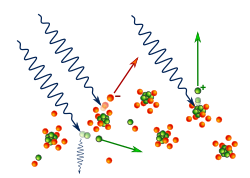
Back انحلال ضوئي Arabic ফটোডিসিন্টিগ্রেশন Bengali/Bangla Kernphotoeffekt German Fotodesintegración Spanish فروپاشی فوتونی FA Photodésintégration French Fotodisintegrazione Italian 光崩壊 Japanese 광붕괴 Korean Fotodezintegracja Polish
This article needs additional citations for verification. (March 2011) |
| Light–matter interaction |
|---|
 |
| Low-energy phenomena: |
| Photoelectric effect |
| Mid-energy phenomena: |
| Thomson scattering |
| Compton scattering |
| High-energy phenomena: |
| Pair production |
| Photodisintegration |
| Photofission |
Photodisintegration (also called phototransmutation, or a photonuclear reaction) is a nuclear process in which an atomic nucleus absorbs a high-energy gamma ray, enters an excited state, and immediately decays by emitting a subatomic particle. The incoming gamma ray effectively knocks one or more neutrons, protons, or an alpha particle out of the nucleus.[1] The reactions are called (γ,n), (γ,p), and (γ,α).
Photodisintegration is endothermic (energy absorbing) for atomic nuclei lighter than iron and sometimes exothermic (energy releasing) for atomic nuclei heavier than iron. Photodisintegration is responsible for the nucleosynthesis of at least some heavy, proton-rich elements via the p-process in supernovae of type Ib, Ic, or II. This causes the iron to further fuse into the heavier elements.[citation needed]